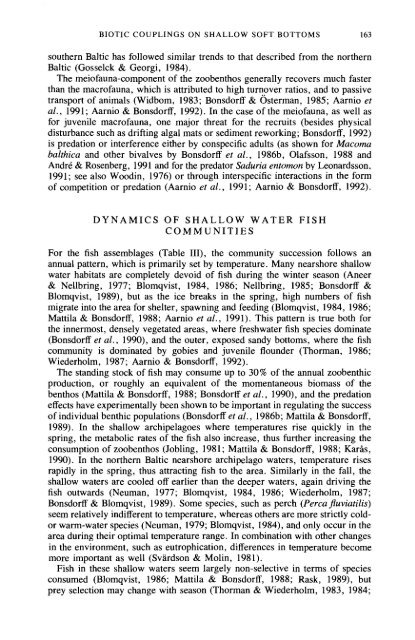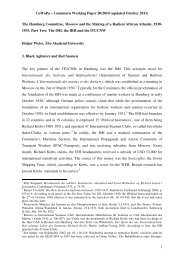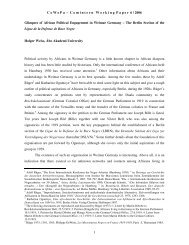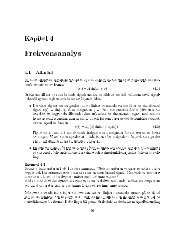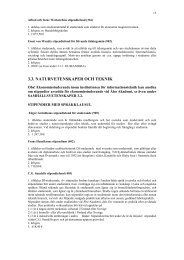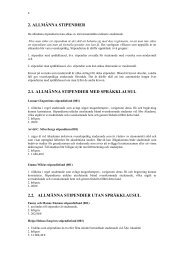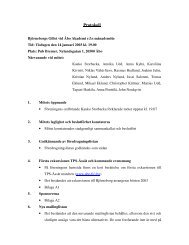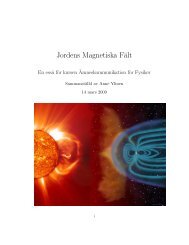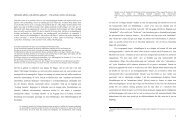biotic couplings on shallow water soft bottoms-examples from the ...
biotic couplings on shallow water soft bottoms-examples from the ...
biotic couplings on shallow water soft bottoms-examples from the ...
You also want an ePaper? Increase the reach of your titles
YUMPU automatically turns print PDFs into web optimized ePapers that Google loves.
BIOTIC COUPLINGS ON SHALLOW SOFT BOTTOMS 163<br />
sou<strong>the</strong>rn Baltic has followed similar trends to that described <strong>from</strong> <strong>the</strong> nor<strong>the</strong>rn<br />
Baltic (Gosselck & Georgi, 1984).<br />
The meiofauna-comp<strong>on</strong>ent of <strong>the</strong> zoobenthos generally recovers much faster<br />
than <strong>the</strong> macrofauna, which is attributed to highturnover ratios, and to passive<br />
transport of animals (Widbom, 1983; B<strong>on</strong>sdorff & ~sterman, 1985; Aarnio et<br />
al., 199 1 ; Aarnio & B<strong>on</strong>sdorff, 1992). In <strong>the</strong> case of <strong>the</strong> meiofauna, as well as<br />
for juvenile macrofauna, <strong>on</strong>e major threat for <strong>the</strong> recruits (besides physical<br />
disturbance such as drifting algal mats or sediment reworking; B<strong>on</strong>sdorff, 1992)<br />
is predati<strong>on</strong> or interference ei<strong>the</strong>r by c<strong>on</strong>specific adults (as shown for Macorna<br />
balthica and o<strong>the</strong>r bivalves by B<strong>on</strong>sdorff et al., 1986b, Olafss<strong>on</strong>, 1988 and<br />
Andrk & Rosenberg, 1991 and for <strong>the</strong> predator Saduria entorn<strong>on</strong> by Le<strong>on</strong>ardss<strong>on</strong>,<br />
1991; see also Woodin, 1976) or through interspecific interacti<strong>on</strong>s in <strong>the</strong> form<br />
of competiti<strong>on</strong> or predati<strong>on</strong> (Aarnio et al., 1991 ; Aarnio & B<strong>on</strong>sdorff, 1992).<br />
DYNAMICS OF SHALLOW WATER FISH<br />
COMMUNITIES<br />
For <strong>the</strong> fish assemblages (Table 111), <strong>the</strong> community successi<strong>on</strong> follows an<br />
annual pattern, which is primarily set by temperature. Many nearshore <strong>shallow</strong><br />
<strong>water</strong> habitats are completely devoid of fish during <strong>the</strong> winter seas<strong>on</strong> (Aneer<br />
& Nellbring, 1977; Blomqvist, 1984, 1986; Nellbring, 1985; B<strong>on</strong>sdorff &<br />
Blomqvist, 1989), but as <strong>the</strong> ice breaks in <strong>the</strong> spring, high numbers of fish<br />
migrate into <strong>the</strong> area for shelter, spawning and feeding (Blomqvist, 1984, 1986;<br />
Mattila & B<strong>on</strong>sdorff, 1988; Aarnio et al., 1991). This pattern is true both for<br />
<strong>the</strong> innermost, densely vegetated areas, where fresh<strong>water</strong> fish species dominate<br />
(B<strong>on</strong>sdorff et al., 1990), and <strong>the</strong> outer, exposed sandy <strong>bottoms</strong>, where <strong>the</strong> fish<br />
community is dominated by gobies and juvenile flounder (Thorman, 1986;<br />
Wiederholm, 1987; Aarnio & B<strong>on</strong>sdorff, 1992).<br />
The standing stock of fish may c<strong>on</strong>sume up to 30% of <strong>the</strong> annual zoobenthic<br />
producti<strong>on</strong>, or roughly an equivalent of <strong>the</strong> momentaneous biomass of <strong>the</strong><br />
benthos (Mattila & B<strong>on</strong>sdorff, 1988; B<strong>on</strong>sdorff et al., 1990), and <strong>the</strong> predati<strong>on</strong><br />
effects have experimentally been shown to be important in regulating <strong>the</strong> success<br />
of individual benthic populati<strong>on</strong>s (B<strong>on</strong>sdorff er al., 1986b; Mattila & B<strong>on</strong>sdorff,<br />
1989). In <strong>the</strong> <strong>shallow</strong> archipelagoes where temperatures rise quickly in <strong>the</strong><br />
spring, <strong>the</strong> metabolic rates of <strong>the</strong> fish also increase, thus fur<strong>the</strong>r increasing <strong>the</strong><br />
c<strong>on</strong>sumpti<strong>on</strong> of zoobenthos (Jobling, 198 1 ; Mattila & B<strong>on</strong>sdorff, 1988; Karas,<br />
1990). In <strong>the</strong> nor<strong>the</strong>rn Baltic nearshore archipelago <strong>water</strong>s, temperature rises<br />
rapidly in <strong>the</strong> spring, thus attracting fish to <strong>the</strong> area. Similarly in <strong>the</strong> fall, <strong>the</strong><br />
<strong>shallow</strong> <strong>water</strong>s are cooled off earlier than <strong>the</strong> deeper <strong>water</strong>s, again driving <strong>the</strong><br />
fish outwards (Neuman, 1977; Blomqvist, 1984, 1986; Wiederholm, 1987;<br />
B<strong>on</strong>sdorff & Blomqvist, 1989). Some species, such as perch (Percajuviatilis)<br />
seem relatively indifferent to temperature, whereas o<strong>the</strong>rs are more strictly cold-<br />
or warm-<strong>water</strong> species (Neuman, 1979; Blomqvist, 1984), and <strong>on</strong>ly occur in <strong>the</strong><br />
area during <strong>the</strong>ir optimal temperature range. In combinati<strong>on</strong> with o<strong>the</strong>r changes<br />
in <strong>the</strong> envir<strong>on</strong>ment, such as eutrophicati<strong>on</strong>, differences in temperature become<br />
more important as well (Svards<strong>on</strong> & Molin, 1981).<br />
Fish in <strong>the</strong>se <strong>shallow</strong> <strong>water</strong>s seem largely n<strong>on</strong>-selective in terms of species<br />
c<strong>on</strong>sumed (Blomqvist, 1986; Mattila & B<strong>on</strong>sdorff, 1988; Rask, 1989), but<br />
prey selecti<strong>on</strong> may change with seas<strong>on</strong> (Thorman & Wiederholm, 1983, 1984;


